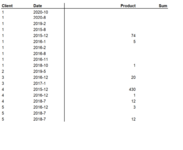Hello,
I would like to do a cumulative sum of the products for each client. It should start from zero if a new client is mentioned and blanks should be treated as zero. I tried to do it with an Indirect(Adress) function,
new client, which did not work out. Here is the screenshot:
Any tips on how to do this?
Best regards,
JJJ
I would like to do a cumulative sum of the products for each client. It should start from zero if a new client is mentioned and blanks should be treated as zero. I tried to do it with an Indirect(Adress) function,
new client, which did not work out. Here is the screenshot:
Any tips on how to do this?
Best regards,
JJJ






